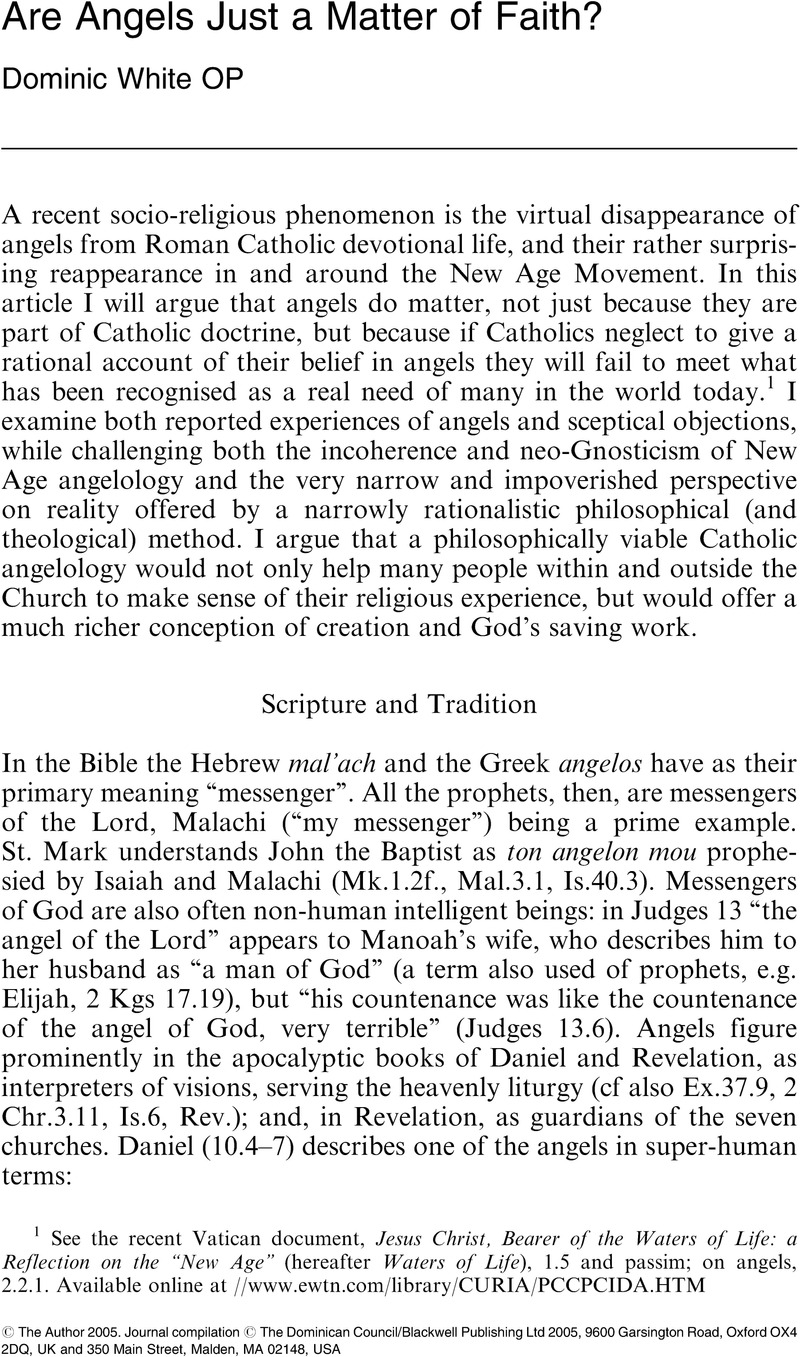Article contents
Are Angels Just a Matter of Faith?
Published online by Cambridge University Press: 01 January 2024
Abstract

- Type
- Original Articles
- Information
- Copyright
- Copyright © The Author 2005. Journal compilation © The Dominican Council/Blackwell Publishing Ltd 2005, 9600 Garsington Road, Oxford OX4 2DQ, UK and 350 Main Street, Malden, MA 02148, USA
References
1 See the recent Vatican document, Jesus Christ, Bearer of the Waters of Life: a Reflection on the “New Age”(hereafter Waters of Life), 1.5 and passim; on angels, 2.2.1. Available online at http://www.ewtn.com/library/CURIA/PCCPCIDA.HTM
2 In Lubheid, C., ed. & trans., Pseudo‐Dionysius: the Complete Works(London: SPCK, 1987), pp. 143–192Google Scholar.
3 See Maritain, J., Le Songe de Descartes(Paris: R.‐A. Correa, 1932)Google Scholar, ch.1.
4 Foster, Kenelm, ‘Angelology in the Church and in St. Thomas’, Blackfriars Summa Theologiae, vol.IX (London: Eyre & Spottiswoode, 1967), Appendix I, p. 301Google Scholar.
5 Rahner, Karl, ‘Angelologie’, in Höfer, J. & Rahner, K., eds., Lexikon für Theologie und Kirche(Freiburg im Breisgau: Verlag Herder, 1957), vol.1Google Scholar, col.533–8, cited by Foster.
6 Ernst, Cornelius, ‘How to See an Angel’, in Multiple Echo: Explorations in Theology(London: DLT, 1979), pp. 187–201Google Scholar.
7 Ernst, p. 197. Compare Georges Huber's My Angel Will Go Before You(Dublin: Four Courts, 1983)Google Scholar, which restates biblical and magisterial teaching (as well as Aquinas), with additional hagiographical material, but makes no attempt at a dialogue with modern sciences such as psychology and shows none of Aquinas’ speculative imagination. At best the book is a brave restatement of traditional piety in an unbelieving world, but really it is unsurprising that Huber (p. 16) finds himself “in the disagreeable company of the naïve and uninformed.”
8 Dec. 1997, pp. 36–40 – see Heathcote‐James, E., Seeing Angels(London: John Blake, 2001), p. 261 ch.1 n.1.Google Scholar
9 E.g. Webster, R., Spirit Guide and Angel Guardians(St. Paul MN: Llewellyn, 1998)Google Scholar.
10 Anonymous source cited by Heathcote‐James, p. 22.
11 Catechism of the Catholic Church, pgh.328.
12 See Chauvet, L.‐M., Symbol and Sacrament: a sacramental re‐interpretation of Christian existence, trans. Madigan, P. & Beaumont, M. (Collegeville: The Liturgical Press, 1995), p. 368Google Scholar.
13 O’Connor, John, ‘Expansive naturalism and the justification of metaphysics in sacramental theology’, New Blackfriars 84 no.898/990 (July/August 2003), p. 365Google Scholar.
14 O’Connor, op.cit. p. 367f.
15 Seeing Angels is based on Heathcote‐James’ PhD thesis, and although a popularization, the book's presentation and criticism of data and conclusions remain “academically intact”.
16 See Tutt, K., True Life Encounters: Unexplained Natural Phenomena(London: Orion Media, 1997), p. 289Google Scholar.
17 See K. Finlay, ‘Angels in the trenches: British soldiers and miracles in the First World War’, Studies in Church History(forthcoming paper).
18 The explanation given by the logical positivist A.J. Ayer for his own NDE in June 1988, during which he “was confronted by a red light, exceedingly bright, and also very painful even when I turned away from it. I was aware that this light was responsible for the government of the universe. Among its ministers were two creatures who had been put in charge of space”(A.J. Ayer, ‘What I saw when I was dead …’, Spectator, 16 July 1988, published in L.E. Hahn, ed., The Philosophy of A.J. Ayer(La Salle: Open Court, 1992), pp. 43–53: this citation, p. 46). Ayer felt that they were not making a good job of it and tried, unsuccessfully, to gain their attention.
19 See website at http://www.melvinmorse.com/light.htm
20 See Finlay, op.cit.
21 A distinction made by Fergus Kerr OP in his discussion of St. Paul's Damascus road experience: Kerr, F., ‘Paul's experience: sighting or theophany?’, New Blackfriars 58/686 (July 1977), pp. 304–313CrossRefGoogle Scholar.
22 Griscom, C., Ecstasy is a New Frequency: Teachings of the Light Institute(New York: Simon & Schuster, 1987), p. 82Google Scholar.; cited in Waters of Life, 2.2.1 n.22.
23 Finlay, op.cit.
24 See Finlay, op.cit.
- 1
- Cited by


